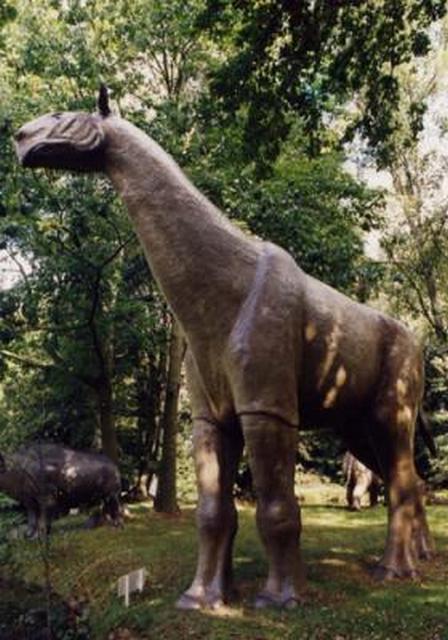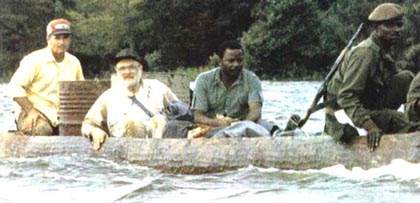
June 22, 2009
If you saw this beast in a rainforest would you have departed carefully after taking photos, and described your encounter with a “dinosaur”?
How about in Lake Tele in central Africa?
For hundreds of years, stories and sightings of supposedly surviving dinosaurs have come out of the jungles of central Africa. The first printed reference, in a 1776 book, relates Abbe Proyhart’s discovery of giant animal footprints in west central Africa, tracks that he claimed were three feet across.
In 1913, a German expedition in the Congo met a band of pygmies who described an animal they called mokele-mbembe, which means “one who stops the flow of rivers.” They said this beast was about the size of an elephant or hippopotamus, with a long, flexible neck and a long tail. This description would be repeated by numerous witnesses. Many would feel that the description was consistent with a sauropod or other small dinosaur.
As I and Patrick Huyghe noted in The Field Guide to Lake Monsters, Sea Serpents, and Other Mystery Denizens of the Deep, the existence of dinosaurs in central Africa is unlikely, but not a total scientific impossibility. According to cryptozoologist Karl Shuker, “If dinosaurs could exist unknown to science anywhere in the world, the Likouala is where they would be.”
But what if Mokele-mbembe aren’t dinosaurs?
I want to propose from another group of supposedly extinct animals a candidate that many of us grew up with, as collectors of little dinosaur figurines and related “prehistoric” toys, what we all knew in our youth as Indriotherium.
Do you remember those huge hornless rhinos mixed in with your dino collection?
Indricotherium, Baluchitherium, or Paraceratherium are names applied to the giant relatives of the rhino.
Discovery Channel has used all 3 names for programs. Walking with Prehistoric Beasts features Indricotherium as a solitary giant living in a relatively arid environment. While the PaleoWorld does a Paraceratherium program, which seems to be the name with priority. Recently, a program on a French expedition excavation in Pakistan uses Baluchitherium. There the environment was reconstructed as a lush jungle. The excavation is of what appears to be a herd that drowned crossing a river seems to indicate a social herd animal….
Indricotherium was the largest land mammal ever to live. This short-lived group of rhinoceros lived [during the Oligocene] in Central Asia and China. It was 27 ft long, as big as some of the extinct sauropods.
Source: Dinosaur Collector
The newer reconstructions of these rhinos (a group that has survived, please note, in Africa and Asia) show them as having elongated necks, like dinosaurs.
Indeed, I have been sent a beautiful and sizable (8″ tall) model of a new representation of Paraceratherium, created for the “Procon Collecta 2009 Prehistorics” collection, which mostly is of dinosaurs, from “Link and Pin Hobbies.”
Darren Naish in 1997 queried about whether was once there was “an indricothere fossil preserved in a standing position? Described by Osborn, I think, this poor animal seems to have become bogged in deep mud. I wonder if indricotheres could gallop.”
I wonder.
BTW/P.S. The just-released “Procon Collecta 2009 Prehistorics” also has other new “extinct” mammals, as shown here via these following two examples.
BTW, remember “MonsterQuest” broadcasts their new program on Mokele-mbembe this week, starting on June 24th. Below is a photo of one of the guides during the MQ expedition.

Roy Mackal, in the Congo, in search of Mokele-mbembe, during one of the modern classic expeditions covered by the original “In Search Of” television series.
Mokele-mbembe with hippo art, at top, courtesy of Bill Rebsamen. Click on illustration for a larger view.
Thank You.
About Loren Coleman
Loren Coleman is one of the world’s leading cryptozoologists, some say “the” leading living cryptozoologist. Certainly, he is acknowledged as the current living American researcher and writer who has most popularized cryptozoology in the late 20th and early 21st centuries.
Starting his fieldwork and investigations in 1960, after traveling and trekking extensively in pursuit of cryptozoological mysteries, Coleman began writing to share his experiences in 1969. An honorary member of Ivan T. Sanderson’s Society for the Investigation of the Unexplained in the 1970s, Coleman has been bestowed with similar honorary memberships of the North Idaho College Cryptozoology Club in 1983, and in subsequent years, that of the British Columbia Scientific Cryptozoology Club, CryptoSafari International, and other international organizations. He was also a Life Member and Benefactor of the International Society of Cryptozoology (now-defunct).
Loren Coleman’s daily blog, as a member of the Cryptomundo Team, served as an ongoing avenue of communication for the ever-growing body of cryptozoo news from 2005 through 2013. He returned as an infrequent contributor beginning Halloween week of 2015.
Coleman is the founder in 2003, and current director of the International Cryptozoology Museum in Portland, Maine.
Filed under Breaking News, Cryptomundo Exclusive, CryptoZoo News, Extinct, Eyewitness Accounts, Fossil Finds, Living Dinosaurs, Megafauna, Mokele-Mbembe, Replica Cryptia, Television